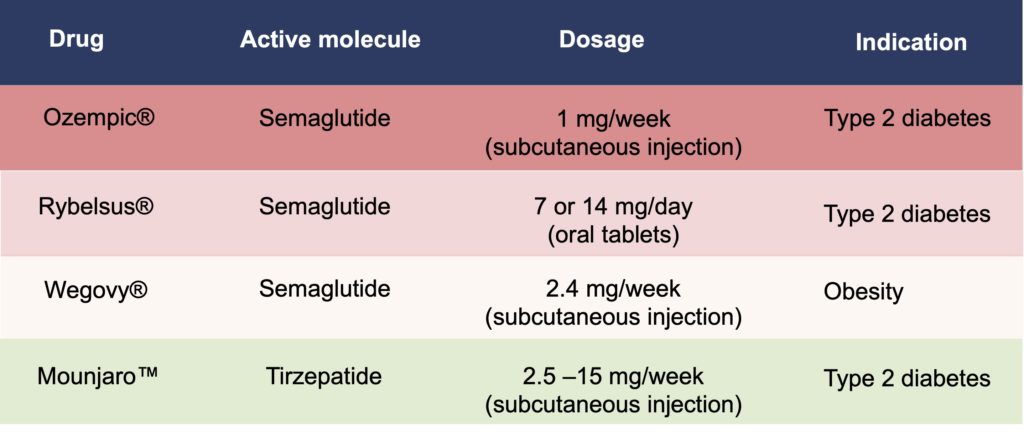Tirzepatide is typically administered once weekly, with doses ranging from 2.5 mg to 15 mg. Semaglutide is also given once weekly, with doses between 0.25 mg and 2 mg. Tirzepatide and Semaglutide are both medications used in the treatment of type 2 diabetes. They belong to the class of drugs known as GLP-1 receptor agonists.
These medications help regulate blood sugar levels and promote weight loss. Tirzepatide has a unique mechanism, targeting both GLP-1 and GIP receptors, potentially offering enhanced efficacy. Semaglutide focuses solely on GLP-1 receptors. Dosage and administration frequency are crucial factors to consider for optimal therapeutic outcomes.
Both drugs are administered via subcutaneous injection, making patient adherence and ease of use essential for effective diabetes management.
Tirzepatide And Semaglutide: Medication Profiles
Tirzepatide and Semaglutide are effective medications for managing diabetes. They help control blood sugar levels. Understanding their profiles is essential for proper use. Below, we explore the key aspects of these medications.
Active Ingredients And Action Mechanisms
Tirzepatide contains an active ingredient that mimics two hormones. These hormones are GLP-1 and GIP. This dual action makes Tirzepatide unique.
Semaglutide focuses on one hormone, GLP-1. It helps increase insulin secretion. It also reduces appetite and slows down digestion.
| Medication | Active Ingredient | Mechanism |
|---|---|---|
| Tirzepatide | GLP-1 and GIP mimetic | Dual hormone action |
| Semaglutide | GLP-1 analog | Single hormone action |
Fda Approval And Clinical Uses
Tirzepatide received FDA approval for treating type 2 diabetes. It is also studied for weight loss.
Semaglutide is FDA-approved for type 2 diabetes and obesity. It has shown promising results in clinical trials.
- Tirzepatide: Type 2 diabetes, weight loss (under study)
- Semaglutide: Type 2 diabetes, obesity
Dosage Forms And Administration
Understanding the dosage forms and administration of Tirzepatide and Semaglutide is crucial for effective treatment. Both medications have different strengths and schedules. This section explores these details to help you make informed choices.
Available Dosage Strengths
Tirzepatide comes in several dosage strengths. These include 2.5 mg, 5 mg, 7.5 mg, 10 mg, 12.5 mg, and 15 mg. Each dosage is designed to meet specific patient needs.
Semaglutide is available in various strengths too. These include 0.25 mg, 0.5 mg, 1 mg, and 2 mg. The range allows for flexible dosing adjustments.
| Medication | Dosage Strengths |
|---|---|
| Tirzepatide | 2.5 mg, 5 mg, 7.5 mg, 10 mg, 12.5 mg, 15 mg |
| Semaglutide | 0.25 mg, 0.5 mg, 1 mg, 2 mg |
Recommended Dosing Schedules
Tirzepatide is usually administered once a week. The starting dose is often 2.5 mg. The dose may increase gradually based on patient response.
- Start with 2.5 mg weekly
- Increase to 5 mg weekly after 4 weeks
- Adjust further based on doctor’s advice
Semaglutide also follows a weekly administration schedule. The initial dose is 0.25 mg. This is usually increased over time.
- Begin with 0.25 mg weekly for the first month
- Increase to 0.5 mg weekly
- Further adjustments depend on the patient’s needs
Consult your healthcare provider before making any changes to your medication. Correct dosing is key for effective treatment.
Evaluating Efficacy In Clinical Settings
Understanding the efficacy of Tirzepatide and Semaglutide in clinical settings is crucial. These medications help manage type 2 diabetes. Comparing their dosages can provide insights into their effectiveness. Let’s dive into the key findings from clinical trials and real-world effectiveness.
Key Findings From Clinical Trials
Clinical trials offer a controlled environment to test medications. Here are the key findings:
- Tirzepatide: Studies show significant reduction in A1C levels.
- Semaglutide: Demonstrated notable improvements in blood sugar control.
Both medications showed promising results in trials. Below is a summary of the dosage and efficacy:
| Medication | Dosage | Efficacy |
|---|---|---|
| Tirzepatide | 5-15 mg | Up to 2.4% A1C reduction |
| Semaglutide | 0.5-1 mg | Up to 1.8% A1C reduction |
Real-world Effectiveness
Real-world data provides a broader view of medication performance. Here’s how each medication fares outside clinical trials:
- Tirzepatide: Patients report sustained blood sugar control.
- Semaglutide: Users experience consistent A1C level reductions.
Both medications are effective in real-world settings. Patient feedback indicates high satisfaction with treatment results.

Credit: observatoireprevention.org
Side Effects And Safety Comparisons
Choosing between Tirzepatide and Semaglutide involves understanding their side effects and safety. Both medications are used to treat diabetes and obesity. Knowing their common adverse reactions and how to manage them can help you make an informed decision.
Common Adverse Reactions
Both Tirzepatide and Semaglutide have some common adverse reactions. Here’s a comparison table:
| Side Effect | Tirzepatide | Semaglutide |
|---|---|---|
| Nausea | Common | Common |
| Vomiting | Moderate | Moderate |
| Diarrhea | Frequent | Frequent |
| Appetite Loss | Common | Common |
| Abdominal Pain | Less Frequent | Less Frequent |
Both medications cause nausea, vomiting, and diarrhea frequently. Appetite loss and abdominal pain are also common but less frequent.
Managing Side Effects
Managing side effects involves a few key strategies. Here are some tips:
- Hydration: Drink plenty of water to stay hydrated.
- Small Meals: Eat smaller, more frequent meals to avoid nausea.
- Avoid Fatty Foods: Fatty foods can worsen symptoms like nausea and vomiting.
- Medication Timing: Take medication at the same time every day.
If side effects persist, consult your healthcare provider. They may adjust your dosage or suggest alternative treatments.
Understanding the side effects and safety of Tirzepatide and Semaglutide is crucial. This knowledge helps in managing your treatment effectively.
Patient-centric Dosage Considerations
Choosing the right dosage of Tirzepatide or Semaglutide is crucial. Each patient is unique, and treatment should reflect individual needs. This section delves into key considerations for personalizing and adjusting dosages.
Personalizing Treatment Plans
Every patient has unique health conditions and goals. Personalizing treatment plans ensures the best outcomes. For Tirzepatide, initial doses often start low. This helps gauge the body’s response.
Semaglutide dosages may vary based on patient needs. Doctors assess factors like age, weight, and existing conditions. This helps in deciding the starting dose and any adjustments needed.
Personalization also considers patient comfort and lifestyle. Both medications can be tailored to minimize side effects. Doctors may use a gradual increase strategy for both drugs.
Monitoring And Adjusting Dosage
Monitoring is key to effective treatment. Patients should have regular check-ups. This helps doctors track progress and adjust dosages. Blood sugar levels and weight are important indicators.
For Tirzepatide, doctors may start with a low dose. They will monitor how the patient responds. If needed, they can adjust the dosage gradually.
Semaglutide requires similar monitoring. Initial dosages may start low. Doctors will check the patient’s response. Adjustments ensure the best results and minimize side effects.
Here is a comparison of typical starting doses:
| Medication | Initial Dose | Adjustment |
|---|---|---|
| Tirzepatide | 5 mg weekly | Based on response |
| Semaglutide | 0.25 mg weekly | Based on response |
Patient feedback is also crucial. Patients should report any side effects. This helps doctors make informed decisions about dosage adjustments.

Credit: cfwls.com

Credit: liquidmobileiv.com
Frequently Asked Questions
What Is Tirzepatide Dosage For Diabetes?
Tirzepatide dosage typically starts at 5 mg once weekly, increasing based on patient response.
How Does Semaglutide Dosage Differ?
Semaglutide dosage usually starts at 0. 25 mg weekly, gradually increasing to 1 mg based on efficacy and tolerance.
Can Tirzepatide Dosage Be Adjusted?
Yes, Tirzepatide dosage can be adjusted based on individual response and tolerance, usually up to 15 mg weekly.
Is Semaglutide Dosage Flexible?
Yes, Semaglutide dosage is flexible, starting low and increasing as needed, with a maximum of 1 mg weekly.
What Factors Affect Tirzepatide Dosage?
Factors include patient tolerance, glycemic control, and potential side effects, requiring close monitoring by healthcare providers.
What Is The Maximum Semaglutide Dosage?
The maximum dosage of Semaglutide is generally 1 mg per week, depending on patient response and tolerance.
How To Monitor Tirzepatide Dosage Effectiveness?
Monitor blood sugar levels regularly and adjust the dosage based on glycemic control and side effects.
Are There Common Side Effects Of Semaglutide?
Common side effects include nausea, vomiting, and diarrhea, which usually subside as the body adjusts to the medication.
Can Tirzepatide Dosage Cause Side Effects?
Yes, potential side effects include gastrointestinal issues like nausea and vomiting, usually managed by dosage adjustments.
How To Switch From Semaglutide To Tirzepatide?
Consult a healthcare provider for a tailored transition plan, considering dosage equivalence and patient response.
Conclusion
Choosing between Tirzepatide and Semaglutide depends on individual health needs. Consult your healthcare provider for personalized advice. Both medications have unique benefits and dosage requirements. Understanding these differences can help you make an informed decision. Stay informed and prioritize your health for the best outcomes.


